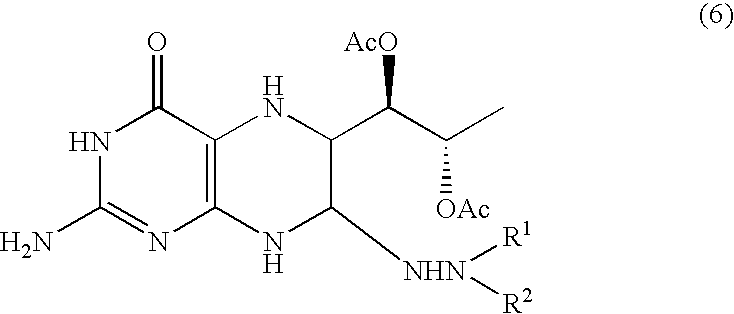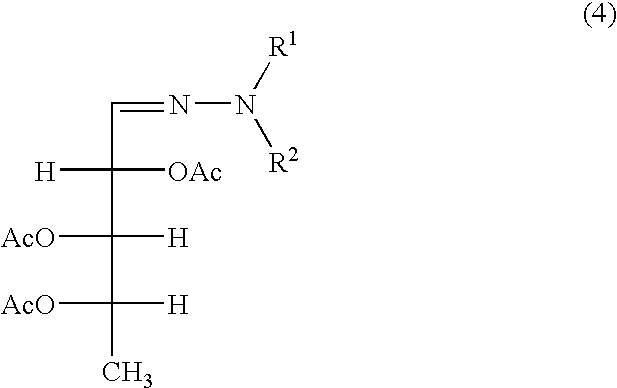Method for producing L-biopterin
a technology of l-biopterin and l-biopterin, which is applied in the field of l-biopterin production, can solve the problems of remarkable yield reduction, decreased productivity, and insufficient industrial production method of phenylhydrazone compound ribose from tartaric acid or r-ribose, and achieves the effects of large industrial production scale, low cost and easy handling
- Summary
- Abstract
- Description
- Claims
- Application Information
AI Technical Summary
Benefits of technology
Problems solved by technology
Method used
Image
Examples
example 1
(1) 1′,1′-diethylsulfonyl-L-rhamnose
[0065]1.2 g of concentrated hydrochloric acid was dissolved in 580 g of acetic acid and then 100 g (0.370 mol) of L-rhamnose diethyl mercaptal was suspended in the resultant solution. Then 200 g (2.06 mol) of a 35% hydrogen peroxide solution was added by dripping to the suspension over 30 minutes, followed by stirring at an ambient temperature of 15° C. over 3 nights. Thereto, was added. An aqueous solution of 4.0 g sodium acetate in 50 ml water. After adding sodium hydrosulfite thereto to deactivate excess hydrogen peroxide, the mixture was subjected to vacuum concentration at an ambient temperature of 40° C. to obtain 1′,1′-diethylsulfonyl-L-rhamnose as its crud product.
(2) 5-deoxy-L-arabinose
[0066]The 1′,1′-diethylsulfonyl-L-rhamnose obtained in the preceding step was dissolved in 500 ml water at an ambient temperature of 40° C. After cooling, the resultant solution was basified with 28% ammonia water. The basified solution was subjected to sti...
example 2
Triacetoxy-5-deoxy-L-arabinose phenylhydrazone
[0068]To the ethyl acetate solution of 5-deoxy-L-arabinose phenylhydrazone obtained in the step (3) of the preceding example, 9.0 g (0.074 mol) of 4-dimethylaminopyridine (DMAP) was added and dissolved therein. Then 120.82 g (1.183 mol) of acetic anhydride was added by dripping to the solution at an ambient temperature of 10° C. After stirring overnight at the same ambient temperature, 250 me of water was added to the solution, which was then stirred for 30 minutes. After allowing the solution to stand, it was separated into a water layer and an organic layer, and a 20% aqueous solution of sodium hydroxide was added to the organic layer up to its neutralization. Then after allowing the solution to stand, its organic layer was separated out and dried over anhydrous sodium sulfate. When the thus treated ethyl acetate solution was subjected to vacuum concentration, an ethyl acetate solution of triacetoxy-5-deoxy-L-arabinose phenylhydrazone ...
example 3
Tetrahydropterin Derivative
[0069]To the ethyl acetate solution of triacetoxy-5-deoxy-L-arabinose phenylhydrazone obtained in the preceding example, were added 500 me of methanol, 41.74 g (0.296 mol) of 6-hydroxy-2,4,5-triaminopyrimidine and 300 ml of water in the cited order. Further, 23.73 g (0.140 mol) of lithium perchlorate trihydrate dissolved in 200 ml water was added thereto and the resultant solution was stirred at 50° C. for 6 hours to obtain an aqueous solution of a tetrahydropterin derivative.
PUM
| Property | Measurement | Unit |
|---|---|---|
| temperature | aaaaa | aaaaa |
| temperature | aaaaa | aaaaa |
| temperature | aaaaa | aaaaa |
Abstract
Description
Claims
Application Information
 Login to View More
Login to View More - R&D
- Intellectual Property
- Life Sciences
- Materials
- Tech Scout
- Unparalleled Data Quality
- Higher Quality Content
- 60% Fewer Hallucinations
Browse by: Latest US Patents, China's latest patents, Technical Efficacy Thesaurus, Application Domain, Technology Topic, Popular Technical Reports.
© 2025 PatSnap. All rights reserved.Legal|Privacy policy|Modern Slavery Act Transparency Statement|Sitemap|About US| Contact US: help@patsnap.com



